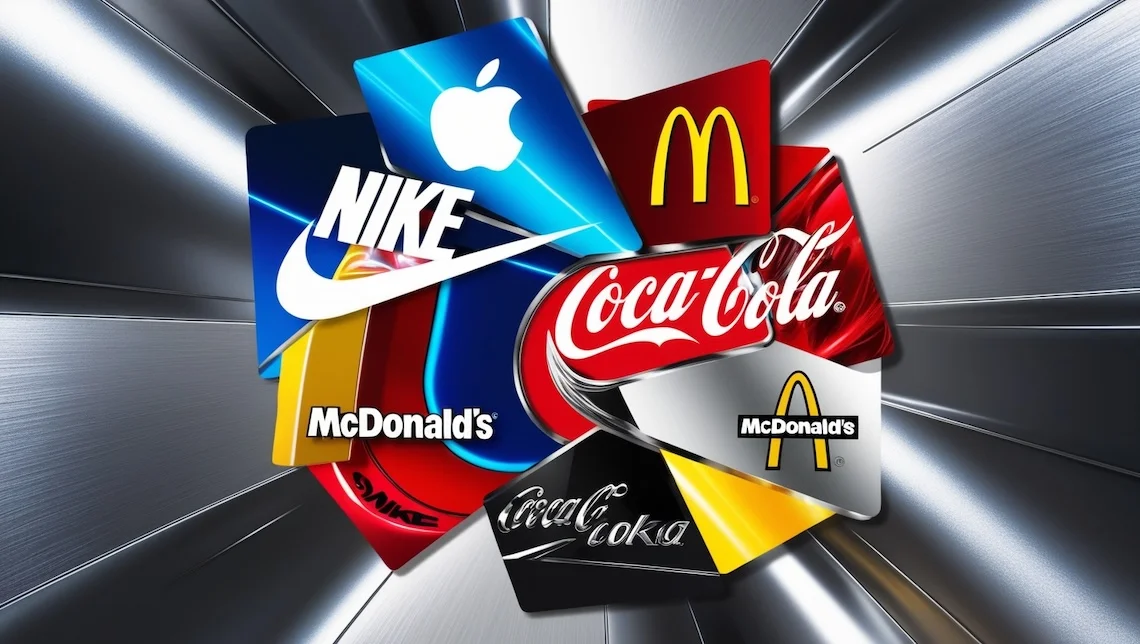

Creating one is challenging and is not reducible only to its graphic expression, such as the logo or brand guidelines.
Creating a successful brand is complex, and it involves the whole company: not only communication but also sales, after-sales, the company, internal processes, personnel, stores, products, social media, and interviews with managers.
And, of course, the customers, their values and their emotions because anything about a company or product can be considered a branding activity.
So, can the logo itself exhaust the definition of the brand?
Obviously, no! I want to answer the questions in this article: What is a brand? How did the concept of a brand come about? What is the definition of a brand? How can a brand be built successfully?
A brand is a distinct and recognizable construct that identifies a company’s offering and embodies the values it has been able to build with a given audience.
In other words, a brand is a tool through which companies create and consolidate the relationship of trust with their customers and convey their reputation about their commercial offer.
As mentioned, a brand is a complex system that is almost alive.
It is constantly changing, perpetually chasing a change defined by practically every business decision: everything the brand does is seen by each customer, who builds their mental representation of it. This idea that each of us builds defines the positioning: we pigeonhole that particular brand in a hypothetical map that contains information on products, the market, needs, competitors, and emotional and value aspects.
A solid and successful brand is not built in a day but is a long process to which thought, you must dedicate strategy, resources, and energy.
It is a fundamental asset of your company and contains within it different perceptual nuances inherent at least:
«Your brand is what people say about you when you’re not in the room [Jeff Bezos]»
Your brand is not your decision but what your customers or prospects think.
You can do all the marketing, communication or corporate storytelling activities you want, but people’s ideas about your company matter. Furthermore, every corporate behaviour is «branding»: from the Christmas gift to the meeting between your sales and his customer, from the company brochure to the reviews on Amazon, from a post on social media to customer service.
Every action and activity of the company affects the heads of your customers and forms the idea that everyone has of your company: the result of this process is the positioning of your brand in a mental map that each of us has in our heads and within which there are also your competitors. The winner is the one who best manages to emerge.
According to the American Marketing Association, the brand is
«A name, term, sign, symbol, or design, or a combination thereof that aims to identify the goods or services of a seller or group of sellers and to differentiate them from those of competitors.»
The definition is correct but dispersive based on what we are currently trying to define. I would say that «a brand is how your customers or prospects perceive your company, based on their direct or indirect interactions with it».
The concept of brand has always existed in any culture and time and has always been linked to the demonstration of belonging to something: it is a way to show who you are, what you fight for and who you work for.
For hundreds of years, artists have signed their works to work on their reputation; knights in the Middle Ages had banners, colours and coats of arms to define their faction, and the military had the ranks that defined the line of command.
And what about the pirate flag raised on the masts of ships during boarding?
The word «brand» in marketing probably comes from the branding of cattle, which in 19th-century America defined the membership of stables.
The need to «brand» through a differentiated and increasingly broad communication strategy arose more than a century ago when the
The Industrial Revolution opened the market beyond its narrow territory.
In a world where everything is local due to obvious logistical difficulties, word of mouth is the first source of new business.
As this narrow world becomes more global, reputation must travel on different channels than the simple referral generated by customers (which, however, despite everything and with other media, remains one of the main levers today).
In this context, a recognizable brand that has built a vital reputation stands as a guarantor of quality and trust and keeps alive that relationship with customers, which, before the Industrial Revolution, was the prerogative only of the direct relationship between people.
In addition, the Industrial Revolution has led to a decrease in product differentiation: today, many products are almost identical, often made with components that, upstream, are made by the same supplier.
Therefore, the brand also becomes a way to differentiate oneself from the competition: this is why a brand is not just a logo but also works on emotional levers, communicating its values and essence.
That’s why the brand helps its consumers choose: I choose Apple because I embrace a philosophy, not so much because the product is necessarily better. The same goes for Nike, Coca-Cola, Ferrari, and any other brand you can think of. Another clarification: I am talking about iconic brands we all know, but they are examples.
Many brands, even small or very niche ones, are examples to follow for consistency, communication, and relational skills.
Simon Sinek said customers don’t buy what you do, but why do you do it?
Knowing why you do what you do not only helps consumers decide but also helps you and your organization make guidelines for organizational and business decisions. Always remember the «why» means having a North Star guiding you, a point on the horizon defining your course.
Nothing binds people together more than a good story. It’s better if your customers can make it their own and tell others who can share it. Building your brand on top of a story, mission, insight, memorable moment, or the person who inspired you has a sense of epic that we may share, making it memorable and relevant.
A strong brand needs a clear and defined Brand identity, a clear selling proposition, clear values, and clarity (and consistency) in its messages to customers and prospects. You can only consider attracting new customers or prospects if you can clearly explain what you can do for them and what problems you can solve.
It sounds trivial, but it’s more complicated than saying it.
A brand is not just a logo, colours, a set of images, or a font.
A strong brand is constant (over time) in its why and consistent (on different media) in its messages. This can be a speech, a blog article, an interview, a podcast, a press campaign, social media, personnel management policy, or customer service. Everything has to be consistent to be credible.
Your audience will judge your brand for every aspect that intersects with customer experience. Customer experience is your brand’s way of delivering on all the promises it has made to its customers. Be careful not to promise what you can’t guarantee and not to underestimate your products or services.
Finally, I emphasize the concept of decision-making. At the beginning of the article, I wrote that the brand helps your customers make decisions.
Let’s take an example: what leads me to choose, I don’t know, running shoes?
Is it the price? It may be important. But my health depends on it.
Do I want to get low-cost shoes that do not guarantee high safety performance, and after a month, I have tendonitis that keeps me still for three months? I don’t think so.
Creating one is challenging and is not reducible only to its graphic expression, such as the logo or brand guidelines.
Creating a successful brand is complex, and it involves the whole company: not only communication but also sales, after-sales, the company, internal processes, personnel, stores, products, social media, and interviews with managers.
And, of course, the customers, their values and their emotions because anything about a company or product can be considered a branding activity.
So, can the logo itself exhaust the definition of the brand?
Obviously, no! I want to answer the questions in this article: What is a brand? How did the concept of a brand come about? What is the definition of a brand? How can a brand be built successfully?
A brand is a distinct and recognizable construct that identifies a company’s offering and embodies the values it has been able to build with a given audience.
In other words, a brand is a tool through which companies create and consolidate the relationship of trust with their customers and convey their reputation about their commercial offer.
As mentioned, a brand is a complex system that is almost alive.
It is constantly changing, perpetually chasing a change defined by practically every business decision: everything the brand does is seen by each customer, who builds their mental representation of it. This idea that each of us builds defines the positioning: we pigeonhole that particular brand in a hypothetical map that contains information on products, the market, needs, competitors, and emotional and value aspects.
A solid and successful brand is not built in a day but is a long process to which thought, you must dedicate strategy, resources, and energy.
It is a fundamental asset of your company and contains within it different perceptual nuances inherent at least:
«Your brand is what people say about you when you’re not in the room [Jeff Bezos]»
Your brand is not your decision but what your customers or prospects think.
You can do all the marketing, communication or corporate storytelling activities you want, but people’s ideas about your company matter. Furthermore, every corporate behaviour is «branding»: from the Christmas gift to the meeting between your sales and his customer, from the company brochure to the reviews on Amazon, from a post on social media to customer service.
Every action and activity of the company affects the heads of your customers and forms the idea that everyone has of your company: the result of this process is the positioning of your brand in a mental map that each of us has in our heads and within which there are also your competitors. The winner is the one who best manages to emerge.
According to the American Marketing Association, the brand is
«A name, term, sign, symbol, or design, or a combination thereof that aims to identify the goods or services of a seller or group of sellers and to differentiate them from those of competitors.»
The definition is correct but dispersive based on what we are currently trying to define. I would say that «a brand is how your customers or prospects perceive your company, based on their direct or indirect interactions with it».
The concept of brand has always existed in any culture and time and has always been linked to the demonstration of belonging to something: it is a way to show who you are, what you fight for and who you work for.
For hundreds of years, artists have signed their works to work on their reputation; knights in the Middle Ages had banners, colours and coats of arms to define their faction, and the military had the ranks that defined the line of command.
And what about the pirate flag raised on the masts of ships during boarding?
The word «brand» in marketing probably comes from the branding of cattle, which in 19th-century America defined the membership of stables.
The need to «brand» through a differentiated and increasingly broad communication strategy arose more than a century ago when the
The Industrial Revolution opened the market beyond its narrow territory.
In a world where everything is local due to obvious logistical difficulties, word of mouth is the first source of new business.
As this narrow world becomes more global, reputation must travel on different channels than the simple referral generated by customers (which, however, despite everything and with other media, remains one of the main levers today).
In this context, a recognizable brand that has built a vital reputation stands as a guarantor of quality and trust and keeps alive that relationship with customers, which, before the Industrial Revolution, was the prerogative only of the direct relationship between people.
In addition, the Industrial Revolution has led to a decrease in product differentiation: today, many products are almost identical, often made with components that, upstream, are made by the same supplier.
Therefore, the brand also becomes a way to differentiate oneself from the competition: this is why a brand is not just a logo but also works on emotional levers, communicating its values and essence.
That’s why the brand helps its consumers choose: I choose Apple because I embrace a philosophy, not so much because the product is necessarily better. The same goes for Nike, Coca-Cola, Ferrari, and any other brand you can think of. Another clarification: I am talking about iconic brands we all know, but they are examples.
Many brands, even small or very niche ones, are examples to follow for consistency, communication, and relational skills.
Simon Sinek said customers don’t buy what you do, but why do you do it?
Knowing why you do what you do not only helps consumers decide but also helps you and your organization make guidelines for organizational and business decisions. Always remember the «why» means having a North Star guiding you, a point on the horizon defining your course.
Nothing binds people together more than a good story. It’s better if your customers can make it their own and tell others who can share it. Building your brand on top of a story, mission, insight, memorable moment, or the person who inspired you has a sense of epic that we may share, making it memorable and relevant.
A strong brand needs a clear and defined Brand identity, a clear selling proposition, clear values, and clarity (and consistency) in its messages to customers and prospects. You can only consider attracting new customers or prospects if you can clearly explain what you can do for them and what problems you can solve.
It sounds trivial, but it’s more complicated than saying it.
A brand is not just a logo, colours, a set of images, or a font.
A strong brand is constant (over time) in its why and consistent (on different media) in its messages. This can be a speech, a blog article, an interview, a podcast, a press campaign, social media, personnel management policy, or customer service. Everything has to be consistent to be credible.
Your audience will judge your brand for every aspect that intersects with customer experience. Customer experience is your brand’s way of delivering on all the promises it has made to its customers. Be careful not to promise what you can’t guarantee and not to underestimate your products or services.
Finally, I emphasize the concept of decision-making. At the beginning of the article, I wrote that the brand helps your customers make decisions.
Let’s take an example: what leads me to choose, I don’t know, running shoes?
Is it the price? It may be important. But my health depends on it.
Do I want to get low-cost shoes that do not guarantee high safety performance, and after a month, I have tendonitis that keeps me still for three months? I don’t think so.

